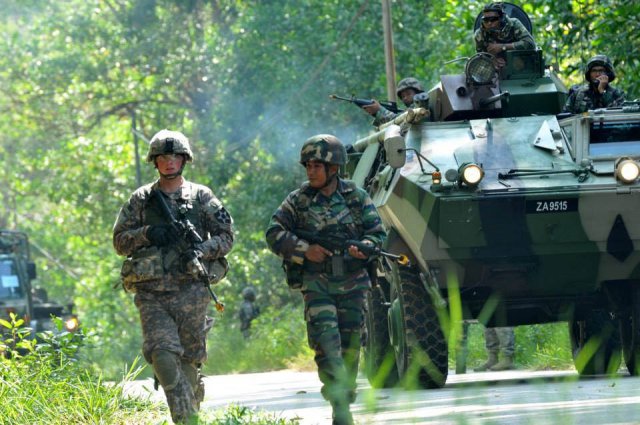
US and Malaysian soldiers training in a Pacific Pathways exercise.
PENTAGON: As the US Army deploys more troops to the Pacific, it’s running into the limits of its long-range communications systems. The shortfall in comms capacity is not only becoming an issue as the service ramps up its “Pacific Pathways” exercises with Asian partners: It is also raising concerns about the network’s resiliency against a cyber attack.
“One of the biggest issues we’re working on is the net[work] architecture,” said Lt. Gen. Stephen Lanza. As commander of Washington State-based I Corps, Lanza routinely deploys forces to East Asia — and he has keep in touch with them across the vast Pacific. “One of the challenges that we have is, when you get forward of the international date line, how [do] you work communications?”
There’s a lot more demand on the network because there are a lot more forces available to deploy to places like Korea, Japan, the Philippines, Indonesia, Thailand, Malaysia, and Australia. After years of I Corps being tapped out supporting deployments in the Middle East, Lanza told reporters at the Pentagon, “all our forces right now are in the Pacific [theater]. I just had my aviation brigade come back from Afghanistan, I just had our fires [i.e. artillery] brigade come back from Iraq.”
“Last year,” said Lanza, “we had over 2,000 people” — regular Army, National Guard, and Reserve — “involved in three different countries” as part of Pacific Pathways exercises. An exercise just getting underway in Thailand will eventually involve “well over a thousand soldiers,” he said, and there’ll be more exercises after that.
No, no, no, “the Army is not trying to be a Marine Corps,” Lanza said when asked if his soldiers were treading on Marine turf. There’s plenty of work for everyone, and the services do different things, he said. When Typhoon Haiyan hit the Philippines, for example, the Marines went in first with their KC-130 and V-22 aircraft — “they are the best first responders we have” — but Army logistics units followed to sustain long-term operations. It’s the Army, incidentally, that provides not only logistical support but much of the long-haul communications for the other services, making the Army’s coms issue potentially everyone’s issue.
With all these Army exercises in the Western Pacific, the day-to-day demand on the communications system is growing — and it’s growing in the theater with the greatest distances in the world and relatively few permanent US bases to provide infrastructure. The demand will only grow as the service downsizes and implements its new Army Operating Concept of more decentralized operations.
But day-to-day communications aren’t the only issue. “The larger concern is the cyber threat,” Lanza said. In fact, he said, cybersecurity looms larger for him than air and missile defense, one of the Army’s major contributions to a prospective “Air-Sea Battle” in the Pacific.
Integrating cyber into theater and tactical-level operations — as opposed to strategic-level espionage — is a growing focus in the US Army. The service recently stood up a new Cyber Center of Excellence and a new corps of cyber specialists. For its part, I Corps is training hard on how to operate under cyber attack, both with the US forces under its command and foreign partners.
“That’s one of the great things about …this bilateral training with Japan,” said Lanza. With I Corps and a 3-star Japanese counterpart HQ working side by side, he said, “we went through that scenario, where we had to sustain our ability to communicate during a cyber attack.”
Lanza intends to conduct similar training with other foreign partners. Within his own command, he continued, “we’re integrating cyber training into the training of the corps as we go up to our certification.”
“That to me is one of the biggest concerns[:] What is the threat to our network?” Lanza said. “How do you build redundancy into the system? How do you build other ways to communicate?” The answers to all these questions — in terms of both training and technology — are very much a work in progress.
Sullivan: Defense industry ‘still underestimating’ global need for munitions
National Security Advisor Jake Sullivan said that there are “no plans” for another Ukraine supplemental at this point.


























